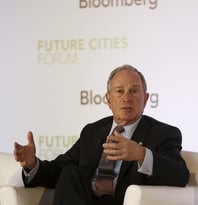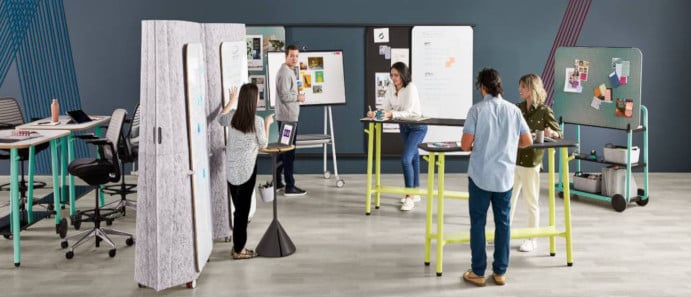How do you solve a problem like a silo? How do you help an agile team to thrive? With an open plan office design? That’s certainly been one response to the modern need for a more integrated, cross-functional approach to team work.
“Open plan is pretty spectacular. It ensures that everyone is attuned to the broad mission, and it encourages curiosity between people who work in different disciplines.”
Josh Tyrangiel, editor of Bloomberg Businessweek
Ever since Michael Bloomberg opened his media HQ in Manhattan in the 1980s, the corporate world has been fascinated by the idea of open-plan as a solution to intransigent and atrophying business cultures.
In this new work paradigm the intention was for employees, at last, to see and hear each other freely, to facilitate intense teamwork; for everything within the workplace to be open, observable and transparent.

Institutional eavesdropping
For Michael Bloomberg, it was a world where workers could “absorb information peripherally while focusing elsewhere”; a phenomenon described by another of his staff as “institutional eavesdropping.”

And if that sounds slightly sinister to you - treading a thin line between encouraging accountability and enabling surveillance - this description of the Bloomberg design in practice, might well confirm your suspicions:
“Row upon row of workstations fan out along endless tables in massive atriums with few dividers to break up the space. On the rare occasion when some sort of partition becomes necessary (for example, to delineate a conference room) the favoured material is clear glass that may block noise but does not obscure vision”
From, The Boss with no Office, 2014
The C-Suite comes out into the open
But if open plan was intended to make individuals and teams more accountable, it also aimed to bring the C-suite out into the open, too, with CEOs setting up desks in the midst of their workforce.
This stressed the idea of accessibility and even the breaking down of traditional hierarchies and privilege, a means of championing the primacy of the team. It’s a practice that the social media Titans, Zuckerberg and Dorsey still follow today.
The success of open plan?
So successful has the open plan philosophy been, this work style is now ubiquitous - according to Steelcase - 69% of offices now have an open floor plan,
However, as the employees of Bloomberg themselves soon discovered and a recent Havard Business School (HBS) study has demonstrated, open plan has simply recast the problem of facilitating teamwork and introduced new obstacles to wellbeing and productivity in the process.
In fact, almost as soon as open-plan became the new normal in businesses across the world, research began to point out flaws in the project.
Why open plan makes us sick
There were certainly more conversations happening between team members but less of any significance because of concerns about privacy. Constant visibility meant there was a general, related rise in anxiety, sickness and absenteeism. Terrible acoustics led to preposterous noise cancelling solutions.
And even though teams had been transposed from individual offices into a single room or floor - they were still located in fixed positions within those floors, workers were still tied to their desks and their computers for the completion of tasks; able to confer with colleagues, but not in any heightened or more meaningful ways than before.
In fact, the HBS study found that open offices reduced face-to-face interaction by about 70% and increased email and messaging by roughly 50%, shattering the notion that they make workers collaborative.
Ironically, open plan still proved a rigid and inflexible solution for businesses that aspired to be agile. It couldn’t bend, change and flex according to the needs of the individuals who worked within it.
Open plan, it seemed, fed disengagement, inhibited team work, cut off access to privacy and actually created discomfort.
Cost effective and easy to grow into
Still, the idea of using large, single spaces to house workers, leasing or buying whole floors without permanent subdivisions, was a cost effective idea and has remained attractive to businesses ever since.
That’s why tech start ups in the noughties internet boom ended up choosing stripped down warehouses and loftspaces as the settings for their ventures - they were inexpensive and easy to grow into - and inadvertently spawned a shabby chic design aesthetic in the process.
How to make open plan spaces work
But the real key as to how to make these spaces work, may lie in an earlier phase of commercial thinking.
In 1959, the visionary architect Edward Parkes, building a cutting edge technical facility in the UK city of Leicester, realised nothing in his designs should be fixed:
“An engineering laboratory if not a static thing, its purpose and content change, often at an alarming rate, with the passage of time. Anything which limits adaptability for the future is, as far as possible to be avoided’
Edward Parkes, Architect, 1959
And it seems this observation has become true for the endlessly evolving and transforming businesses of today, too. In the age of Agile working, hyperconnectivity and rapidly superseded technology, the needs of individuals and teams are changing constantly. The purpose and content of our work can alter on a daily or hourly basis.

The future of open plan reimagined - endlessly configurable spaces
Configure and reconfigure
There is now a real need to constantly configure and reconfigure a workspace on the fly, to support the changing activity, technologies and behaviours that it is required to host. But most offices, even those that are open plan, are currently unequal to this challenge.
This inflexibility has led to a kind of nomadism within a typical office space, with groups and individuals searching fruitlessly for space where they can complete the tasks required of them. Recent Steelcase research has shown that although 77% of people have their own assigned work station, 87% spend to two to four hours every day working somewhere else. Meanwhile, 53% of workers say they can’t find the spaces they need in their current office to perform at their best.
Open plan has historically failed to deliver the right conditions for teams whose needs shift between collaborative work, private meetings, concentrated individual focus, and larger team gatherings.
But it’s not the open space itself that is at fault, but what we do with it and how we choose to fill it that is causing the problem.
So now, thinkers and designers are beginning to reimagine furniture solutions that make the most of the open plan spaces we have.
“Rather than a one-size-fits-all approach, as is traditional in open plan design, work environments should provide various options that support employees working effectively.”
Katharine Schwab, The Fast Company
Instead of fixed, immovable, workstations, chairs and desks - cutting edge designers are advocating a new breed of furniture solution which enables the office to change around us.

In this new world we will be able to maximise our efficiency and productivity through an endless ability to flex.










